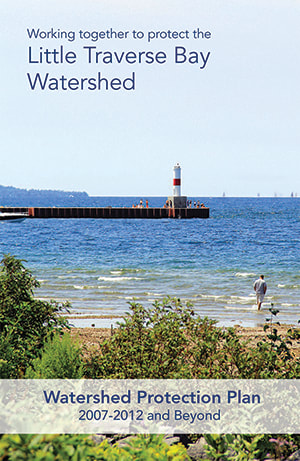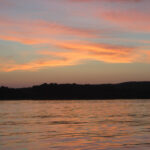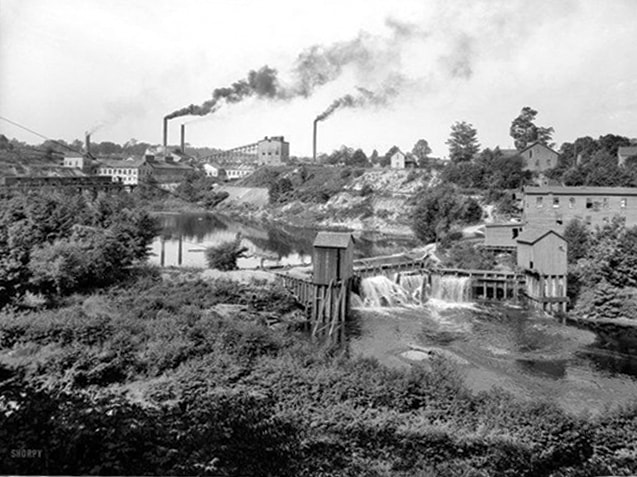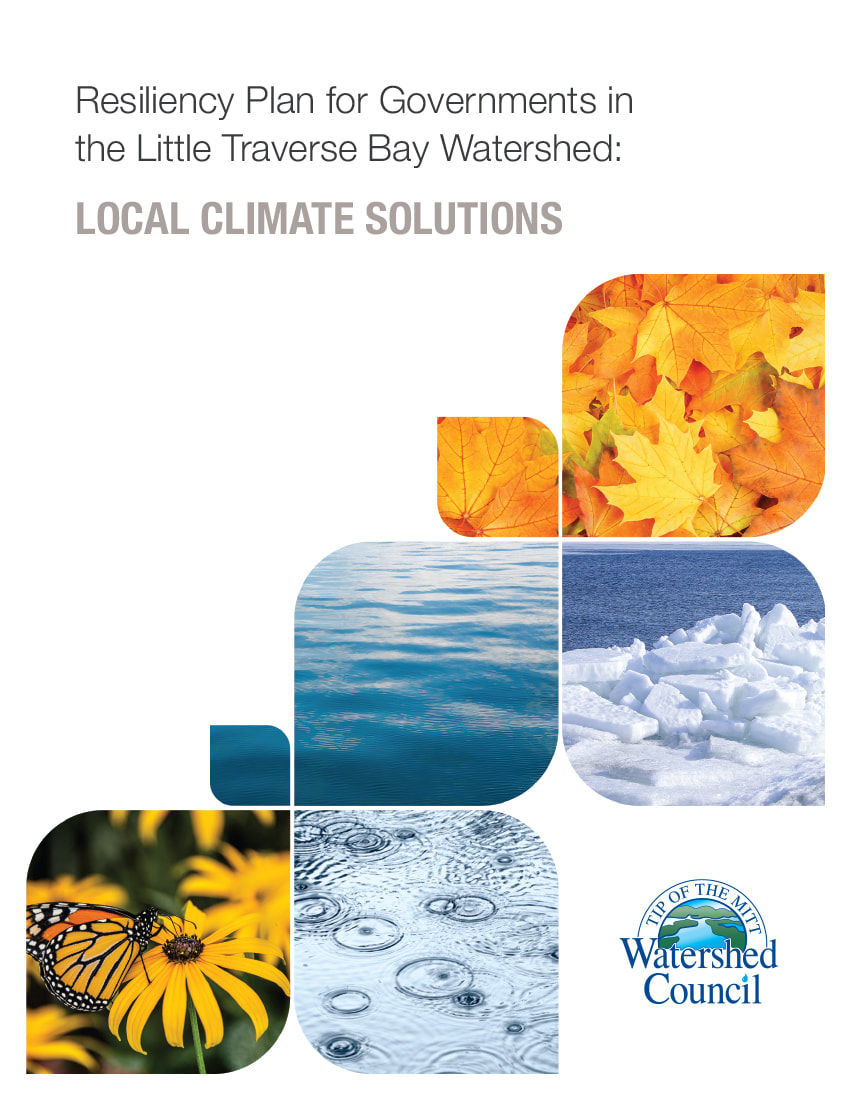Description:
For centuries, the Odawa Indians made their home along the lakeshore of Little Traverse Bay. The strategic location of the Bay on the Great Lakes and its abundant natural resources made it desirable not only for Native Americans, but also for early European settlers. French explorers traveling along the east coast of Lake Michigan found two large embayments along their way. During calm weather, they crossed the bays’ mouths in their canoes to save time. The northernmost bay had a slightly narrower mouth and they called this la petit travers – the little traverse.
The abundance of natural resources, and ease of harvesting and transporting them, made the area’s economy flourish. Lumbering and fur trading were extensive within the Watershed. The Bear River made it easy for transporting logs to the Bay where large ships waited to take them to points all along the Great Lakes. Fishermen harvested whitefish and lake trout from the Bay. Limestone and shale along the south shore of the Bay supported cement manufacturing. In addition to all of the industrial and extractive uses, the natural beauty of Little Traverse Bay also attracted visitors from across the country. By the 1880’s, several resort communities were well established. By the time Michigan became a state, well over 100 years of fur trading, resource extraction and development had already taken its toll on the Watershed.
Ironically, the water resources that continue to enrich the area are still threatened. Overdevelopment, invasive species, and pollution from stormwater runoff are just a few of the threats they face today. The balance of supporting the local economy while preventing resource degradation is an ongoing challenge.
Geographic Description:
- At approximately 45 square miles, Little Traverse Bay is Lake Michigan’s fourth largest bay, behind Green Bay, Grand Traverse Bay, and Bay DeNoc.
- The Bay is 3.5 miles wide between Petoskey and Harbor Springs, eight miles wide between Nine Mile Point and Seven Mile Point, and approximately 10 miles long.
- The Little Traverse Bay Watershed land area covers 174 square miles and contains a diversity of water resources, including Walloon Lake, the Bear River, and its tributaries.
Watershed Boundaries
The Little Traverse Bay Watershed is one of Northern Michigan’s larger watersheds covering
approximately 174 square miles or 111,207 acres in Emmet and Charlevoix Counties. Emmet County townships within the Watershed include Friendship, Pleasantview, West Traverse, Little Traverse, Resort, Bear Creek, and Springvale. Charlevoix County townships within the Watershed include Bay, Evangeline, Melrose, Chandler, Boyne Valley, and Hudson. The Little Traverse Bay Watershed includes the municipalities of Petoskey and Harbor Springs, and the unincorporated village of Walloon Lake.
Lake Michigan and Little Traverse Bay’s early formations started about 570 million years ago during the Devonian Period when shallow productive seas were located in what is now Michigan. Over the next 240 million years a succession of seas existed, and deposits of limestone were laid down on the bottom of each. These seas were full of worms, mollusks, corals, and other invertebrates. The fossil remains are common in the shoreline rocks, including fossils of an extinct species of coral unique to this area called Petoskey Stones.
Between 330 and 2 million years ago, the seas drained away and the land was uplifted. River valleys were eroded into the limestone. A large river flowed through a broad deep valley in what is now Lake Michigan and a smaller tributary carved a valley between different limestone deposits in what is now Little Traverse Bay.
Beginning about 2 million years ago and lasting to as recently as 10-12,000 years ago, a series of four continental glaciers descended from the north. The glaciers widened and deepened the river valleys and eventually left them filled with water.
After the glaciers left, the water went through a series of wide fluctuations. About 10,000 years ago, glaciers blocked the outlet to the north and held the water 160 feet higher than it is now. Geologists have named that water body Lake Algonquin. After the glaciers retreated furthernorth, they uncovered a northern outlet, and the water fell to a level 350 feet below the present level (called Lake Chippewa). At that time (9,500 years ago) Little Traverse Bay was completely dry and probably forested. As the land, and the outlet’s elevation, rebounded from the weight of the glacier, the lake level again rose, reaching a height of about 25 feet above the present level.
Features formed by those ancient lakes are still visible on the landscape today. Flat, level, sandy terraces deposited in the nearshore waters of Lakes Algonquin and Nipissing are visible across the water as parallel treelines on the Bay’s north shore east of Harbor Springs. The Harbor Springs airport and M-119 on the north side of the Bay and the Petoskey business district are built on the Algonquin Terrace. The sand dunes at Petoskey State Park were created by the rising waters of Lake Nipissing and wind action. The high hills north of the Bay where the ski hills are located are glacial moraines which were an island (named Brutus Island) during Algonquin times.
The fossil-rich limestone bedrock from which Little Traverse Bay was carved is close to the surface on the south shore, and is visible in Petoskey’s Bayfront Park and at Bay Harbor. The proximity of this limestone to the surface resulted in a cement industry developing in the area. The constant movement of sand from west to east along the north shore of the Bay by wave action and wind-generated currents has created a recurve sand spit known as Harbor Point. The Point continues to grow very slowly, and theoretically, in tens of thousands of years may grow completely across the harbor and form an inland lake.

Resiliency Plan for Governments in the Little Traverse Bay Watershed: LOCAL CLIMATE SOLUTIONS Thanks to the generous support of the Petoskey-Harbor Springs Area Community Foundation we were able to produce the “Resiliency Plan for Local Governments in the Little Traverse Bay Watershed.” The purpose of this report is to help inform natural resource managers and local officials about expected impacts from our changing climate and help local governments make our coastal cities resilient to these changes. Information and resources found in the document also support the overarching goals of the Little Traverse Bay Watershed Protection Plan. |
 | Little Traverse Bay Watershed Protection Plan – 2007-2012 and Beyond Brochure highlights the accomplishments of the Plan from 2007-2012. |
Additional Publications:
| Title | Link |
|---|---|
| Little Traverse Bay Watershed Protection Plan – 2007-2012 and Beyond Brochure – Side 2 | |
| Little Traverse Bay Watershed Protection Plan – 2007-2012 and Beyond Brochure – Side 1 | |
| Comprehensive Water Quality Monitoring (CWQM) | |
| 2007 Little Traverse Bay Watershed Management Plan |







